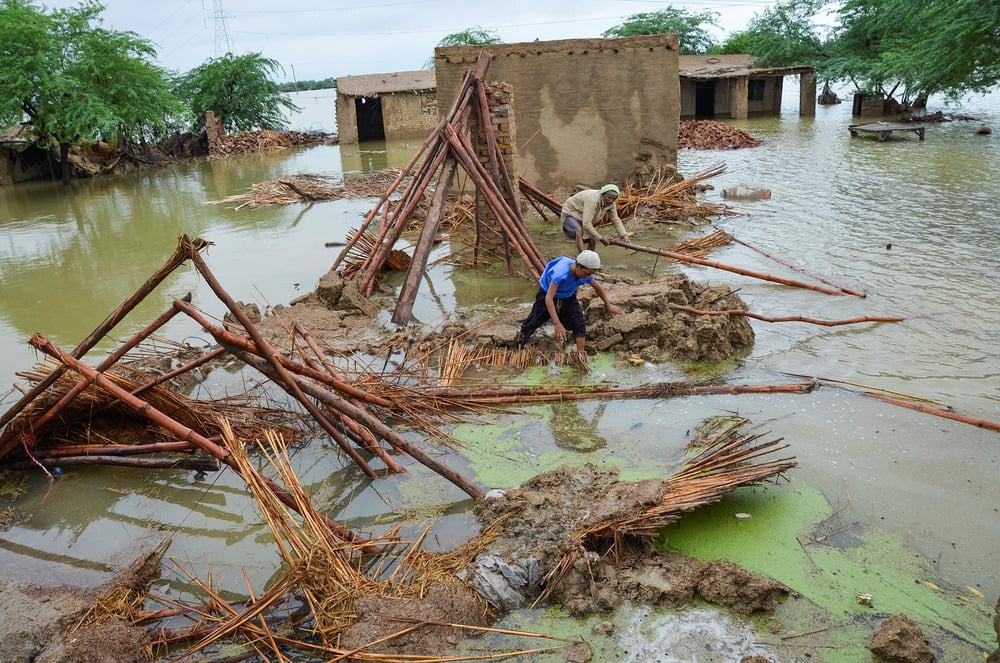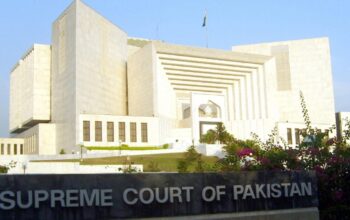“…recent exceptional floods have destroyed human, physical, and livestock capital and deprived many families of their assets and incomes. Besides the cost in terms of lost lives and capital, these events will certainly affect the creation of gross value added and hence economic growth.”
By Staff Reporter
ISLAMABAD: The outlook for Pakistan’s economy darkened due to recent flash floods with inflationary and external pressures continuing to hamper growth and a range of economic indicators pointing towards an impending crisis, the finance ministry said.
“The economic outlook for Pakistan in the current fiscal year has become uncertain and will likely remain below the target,” the ministry said in its Monthly Economic Outlook.
“…recent exceptional floods have destroyed human, physical, and livestock capital and deprived many families of their assets and incomes. Besides the cost in terms of lost lives and capital, these events will certainly affect the creation of gross value added and hence economic growth.”
Inflation
Inflation has started reverting as the month-on-month price increases have been on a declining path during the last two months. Though, the year-on-year inflation has shown a significant acceleration from June till August. One reason is a steady decline in international food and oil prices during the last two months. Consumer Price Index (CPI) inflation will remain in the range of 21-22.5 percent.
On the other hand, since March, the rupee is depreciating against the dollar. One worrisome problem is the devastating effects of recent floods which have destroyed a substantial part of crops. However, their effects on inflation are being alleviated by prompt government measures to counter forms of price speculation and to provide sufficient supplies by allowing trade from neighboring countries. Still, the risk of second-round effects of recent inflationary shocks persists which may work themselves through the markets.
Agriculture
The agricultural outlook is still not clear as the output of both important and other Kharif crops has suffered significantly due to recent floods and unprecedented heavy monsoon rains. The stay of water in the cropping area may also affect the sowing of Rabi crops. Production of sugarcane decreased by 7.9 percent to 81.6 million tons against 88.7 million tons last year, while rice production declined by 40.6 percent to 5.5 million tons against 9.3 million tons. Maize production decreased by 3 percent to 9.2 million tons and that of cotton by 24.6 percent to 6.3 million bales.
Production and sales of tractors declined by 36.2 percent (7,991 units) and 30.3 percent (8,379), respectively, in July-Sept FY23, while the agriculture credit disbursement increased by 31.5 percent to Rs384 billion. During the Kharif season (April-September), urea and DAP offtake was 3,137,000 tons and 491,000 tons.
Industry
Industrial activity, measured by the LSM index is the sector that is most exposed to the developments in international markets. Most recent data show a convergence of Pakistan’s cyclical position to that of its main trading partners. As expected, in July, international economic slowdown and domestic negative seasonal effects dragged down LSM as compared with its level recorded in June, whereas on a year-on-year basis, LSM showed relative stability. For August moderate growth both on a month-on-month and year-on-year basis can be expected, unless the effects of the recent floods would jeopardize this scenario.
The stabilization measures in the form of monetary and fiscal tightening, and import compression strategies to correct the imbalances also suppressed LSM by 0.4 percent during July-Aug FY23 against the growth of 11.3 percent during the same period last year. Eight out of 22 sectors witnessed positive growth, while the output of 14 others declined.
External
According to the balance of payment data, the trade deficit in goods and services expressed in dollars declined marginally in July. Both exports and imports gained strength. For the coming months, the baseline scenario is moderation in imports, following a domestic growth slowdown. At the same time, exports would stabilize, helped by a relatively stable REER at historically low levels. As a result, the trade balance could be expected to improve. Remittances are expected to stabilize at around current levels.
This together with the expected path of the trade balance and other primary and secondary income transactions would guide the current account balance toward further improvement. But this scenario may be perturbed significantly by the consequences of the recent floods. These may limit export capacity and at the same time require more imports to satisfy the demand for products and harvests foregone. The current account posted a deficit of $2.2 billion for July-Sept FY23 as against $3.5 billion last year
Fiscal
For FY2023, the fiscal deficit is budgeted to reduce to 4.9 percent of GDP, while the primary balance is a surplus of Rs153 billion. The budget for FY2023 was prepared to achieve the goals of stabilizing economic growth, increasing revenues, rationalizing expenditures through prudent expenditure management, enhancing exports, and protecting the vulnerable segments of society through relief measures and proper initiatives.
The fiscal deficit in the first two months (July-August) of the current fiscal year was at 0.9 percent of GDP or Rs672 billion against 0.7 percent of GDP or Rs462 billion last year.
However, the economy of Pakistan has been affected severely by widespread destruction brought by extreme flooding. Consequently, there will be a detrimental impact on the government’s fiscal situation from both the revenue and expenditure sides.
Foreign Investment
Foreign direct investment during the first quarter of the current fiscal year dropped by 47 percent to $253.4 million. Foreign private portfolio investment registered a net outflow of $12.1 million during July-Sept FY23. Foreign public portfolio investment recorded a net outflow of $18.2 million.
The total foreign portfolio investment recorded an outflow of $30.3 million during July-Sept FY2023. Total foreign investment during July-Sept FY23 reached $223.1 million against $1.358bn last year. In July-Sept FY23, workers’ remittances were recorded at $7.7 billion against $8.2 billion last year.
Economic Activity
The Monthly Economic Indicator (MEI) is based on combining monthly data of indicators that are proven to be correlated with GDP at constant prices. Since the start of the current fiscal year, economic activity seems to have fallen to a lower growth path. Contributing indicators to this observation are the growth slowdown in the rest of the world, limited year-on-year growth in manufacturing, high domestic inflation, eroding real incomes, and raising production costs.
Copyright © 2021 Independent Pakistan | All rights reserved




